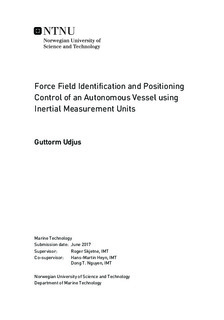Force Field Identification and Positioning Control of an Autonomous Vessel using Inertial Measurement Units
Master thesis
Permanent lenke
http://hdl.handle.net/11250/2456115Utgivelsesdato
2017Metadata
Vis full innførselSamlinger
- Institutt for marin teknikk [3432]
Sammendrag
In this thesis, a system of four sensors for measuring tri-axis translational accelerations and rotational velocities is designed. The sensors were mounted with a spatialdistribution on board the ship model C/S Arctic Drillship. Experiments were carriedout and sensor data was collected for waves with various periods and incoming directions.The distributed acceleration measurements were used to estimate translationaland rotational accelerations in Center of control. By comparing the estimated accelerations with the high-accuracy measurements from Qualisys, it was found that the system providesgood estimates of the accelerations in Center of control. In addition, the local tri-axistranslational accelerations in each sensor frame was estimated, to detect spatial variability of accelerations. This method also performs well, and provides a representationof local forces in the hull.Three methods to estimate the direction of incoming waves are proposed, whereone is based on correlation between motion in roll, pitch and yaw, and the two othersare based on local accelerations inside the hull. Analysis of motion in roll, pitch andyaw gave some results. Analysis of the horizontal accelerations in the hull was notsuccessful as to detect the surrounding force field, while the heave accelerations gave abetter image of the surrounding waves and forces. An algorithm for online estimationof direction of incoming waves was proposed, which was able to predict the directionof incoming waves for some periods.For a short video of some of the experiments and findings, the reader is referred to https://vimeo.com/222068786. In this video, the spatially distributed accelerations in each sensor are shown when the waves hit the vessel
